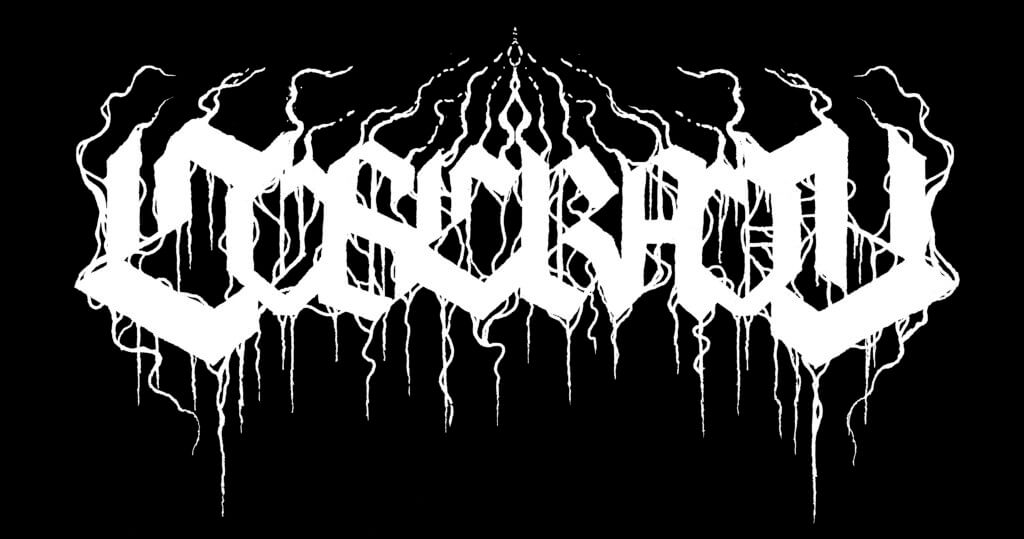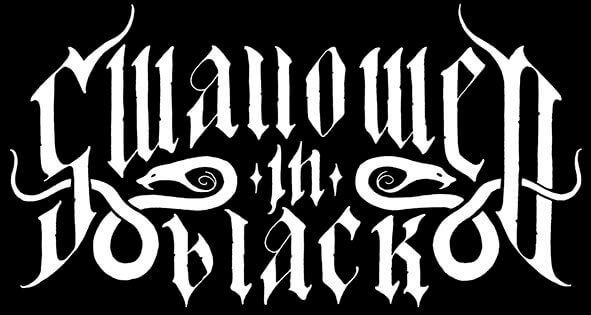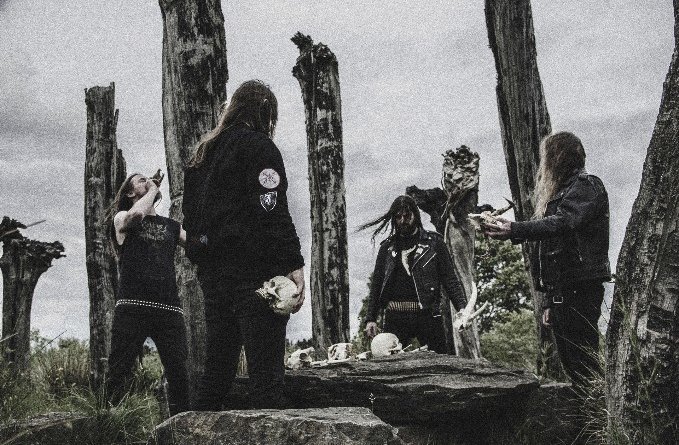“THE USAGE OF GAELIC LANGUAGE IN COSCRADH REFLECTS THE PARTICULAR BRUTAL STORIES BEING TOLD AND ATTEMPTS TO REFLECT THE TIME PERIOD” – CIARÁN Ó CRÍODÁIN
June, 2023: in conspiracy with cross-Atlantic cousins Ascended Dead and to commemorate with slaughterous and deadly deeds the advent of their debauched debut full-length, ‘Nahanagan Stadial’, uncompromising Celtic crusaders Coscradh – armed with an inherently Irish and eerily ancient maelstrom of brutal Black / Death Metal alchemy – embarked on a magnificent musical massacre along the Pacific Coast of North America. Upon the band’s triumphant return from this historic conquest to elements- and history-battered native shores, Ciarán Ó Críodáin graciously accepted an invitation from a fellow islander to document the many twists and turns of the glorious West Coast Apocalypse; our inexorable acceleration towards the end of times; the might, majesty and cataclysmic wrath of the old gods of nature; honouring through art and action the innate identity, culture, language and ancestry of one’s place of birth; and the rapture of great floods.
 Coscradh recently completed the wonderfully-named West Coast Apocalypse tour – an ambitious and bold North American campaign of violence that stopped off at iconic venues along the Pacific Coast from Mesa, Arizona to Vancouver, British Columbia, also taking in San Diego, Los Angeles, Sacramento, Oakland, Eugene, Portland and Seattle within the space of ten hectic days in early June. It sounds mightily impressive, but this was a massive undertaking for a humble Black / Death Metal band from Ireland. How rewarding, invigorating and successful was this unique experience?
Coscradh recently completed the wonderfully-named West Coast Apocalypse tour – an ambitious and bold North American campaign of violence that stopped off at iconic venues along the Pacific Coast from Mesa, Arizona to Vancouver, British Columbia, also taking in San Diego, Los Angeles, Sacramento, Oakland, Eugene, Portland and Seattle within the space of ten hectic days in early June. It sounds mightily impressive, but this was a massive undertaking for a humble Black / Death Metal band from Ireland. How rewarding, invigorating and successful was this unique experience?
“The idea was to promote our album in a way that was as interesting as possible for ourselves. We had an original plan to play Total Death over Mexico, head into the States and from there attempt to set up a tour with Ascended Dead, who had also been announced for the festival. I reached out to them with the idea, as a fan of their music ever since it first appeared on Invictus around the same time as our first demo. After that edition of the fest fell through, we decided to shelve the idea until Ascended Dead had also put out their album. Their release actually happened much quicker than anticipated and Jon had a lot of the groundwork already (painstakingly) done.
“Though it may seem like a massive undertaking on our part, it still made sense logistically / financially and we had infinite help from our friends in Ascended Dead, Alvin from Elergy Ensemble / Knucklehead Hollywood, Alvaro and the guys from Unholy Lust, Nacho from Sacrifice / Born for Burning, Sadat from Black Vomit Propaganda and the many great promoters, bands and people up along the coast. It was a victorious venture, a great success all around and something we’re never going to forget.”
Going back to the genesis of Coscradh eight years ago, did you even dare to dream that such an opportunity might one day present itself? Does the West Coast Apocalypse represent one of the highlights of the Coscradh crusade thus far? With the dates coming so thick and fast, was there much opportunity to drink it all in and enjoy yourselves, to perhaps take in some sightseeing? And did you encounter much hardship along the way?
“No, not at all. The original idea for the band was recording one demo that we felt represented brutal ancient Ireland and firing it out to oblivion, until Darragh caught wind of it, released it and cast us into a trial by fire supporting Tribulation for our first gig. Today, we’ve an absolutely possessed lineup and are currently writing the second album.
“From receiving the ‘Nahanagan Stadial’ LP on vinyl last year to getting to play it on this glorious campaign of barbarism has certainly been the highlight of the band’s career thus far.
“Irish will always make sure to find a way to drink it all in; first ports of call in each city were your numerous IPA breweries, which was a pleasant break from Miller light or Busch road beers. Took in the sand dunes of the Arizona desert, which is a Mars-like landscape, beaches around San Diego up to LA, Manhattan Beach, the shocking Hollywood hellscape, San Fran city, then out of the chaos and up north into the nice quiet town of Eugene for two nights of recovery from an insane 20 hours of driving the day before, lush green mountains north of there up to Seattle, which was a cool, culturally vibrant city and then to beautiful Vancouver boating from brewery to brewery.
“It wasn’t all smooth sailing of course. From the very beginning of the tour and all the way up the coast warnings foretold of this shithole known as Oakland (apologies to regular Oaklanders) and also the Canadian border crossing making it difficult for musicians. And, as fate would have it, we got our truck broken into in Oakland right outside the venue as we were loading in, with nothing but Jason’s passport stolen. After a few trips around the block, we quickly realised it wasn’t a neighbourhood where you go launching your own investigation, so we drowned our sorrows after the show and the next day we landed into the Irish embassy early, which happened to be only an hour away … one of a total of two on the entire west coast. We were promptly removed from the building for being there without an appointment. As we were sitting outside contemplating our next move, another security guard came out to notify us that we need to get the fuck off the steps. Luckily this one noticed that we might be in a bit of trouble and got us an instant meeting with the ambassador for a temporary passport application (located in LA). Not the perfect solution but it would have gotten us to Seattle at least. After a truck replacement and a few hours into the journey north, the embassy called notifying us that someone had delivered the stolen passport to them. So back to San Fran we went, continuing our celebratory 20-hour drive. Later in the tour, Ascended Dead were cool enough to smuggle our instruments across to Canada and we bussed it from Seattle to Vancouver, giving our best tourist impressions at the border, four passports intact.”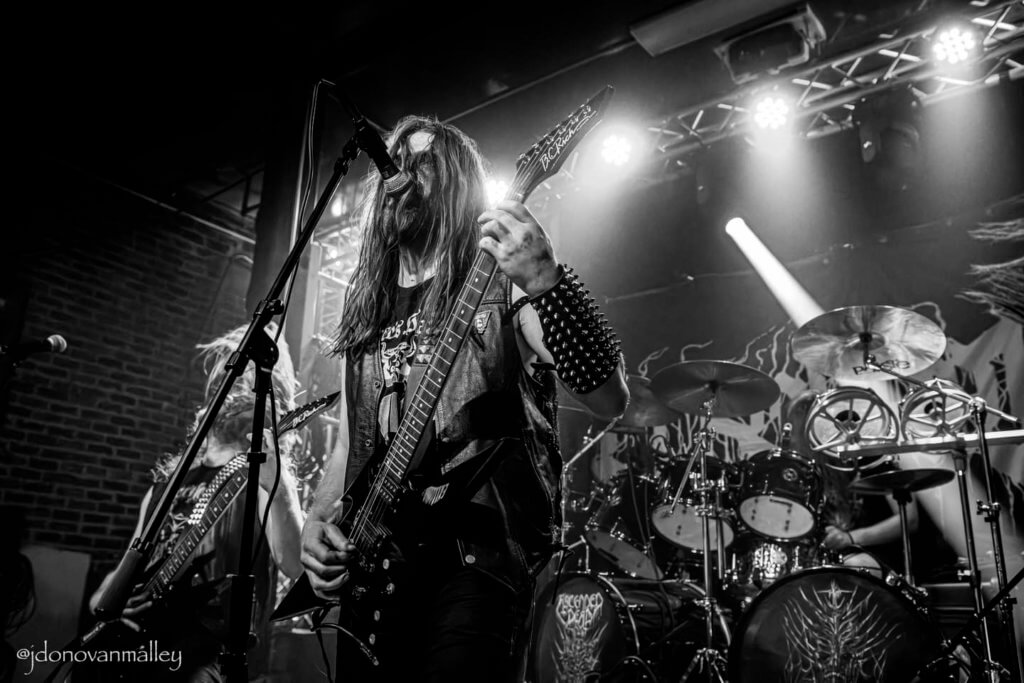 A worthy way to mark and celebrate your debut full-length! Occasional ambient flourishes aside, ‘Nahanagan Stadial’ is a devastating onslaught, ferociously intense and barbaric, with little or no concession to accessibility or palatability – a gloriously jarring musical massacre. What sort of feelings or emotions provoked such a violent and unrestrained sonic eruption? Did you set out with the objective of making as aggressive, pummelling and hostile a record as possible, or is the album simply an accurate reflection and continuation of everything Coscradh represents?
A worthy way to mark and celebrate your debut full-length! Occasional ambient flourishes aside, ‘Nahanagan Stadial’ is a devastating onslaught, ferociously intense and barbaric, with little or no concession to accessibility or palatability – a gloriously jarring musical massacre. What sort of feelings or emotions provoked such a violent and unrestrained sonic eruption? Did you set out with the objective of making as aggressive, pummelling and hostile a record as possible, or is the album simply an accurate reflection and continuation of everything Coscradh represents?
“It felt like a natural progression. We took our time on this release to get it as close as possible to what the band represents. We found our feet with the 2017 EP. Even if it didn’t exactly sound as intended, the violence represented in ‘Saor sa hAnbháis’ was an experience we wanted to elaborate on much more; doom, death and black metal elements combined. Each song on the album was individually distilled and dissected to be as impactful as possible.”
Complementing the music perfectly, the theme of the album is equally apocalyptic. Nahanagan Stadial is the Irish term for the Younger Dryas – a catastrophic geological event which brought a devastating ice age to the island of Ireland some 10,000 years ago, rendering life extinct (I don’t know if there were any human settlements on the island at the time?). What drew you to this subject matter? Does an arbitrary, transformative ‘Act of God’ such as this demonstrate the degree to which all life on the planet is at the mercy of nature?
“The earliest known human activity here is over 12,500 years ago. After that, there are thousands of years of inactivity following the subsequent cataclysmic event which caused the ice age that wiped out any hunter gatherers on the island. At a lake in County Wicklow known as Lough Nahanagan (lake of the beast), it was recently discovered by Irish geologists that the ice sheet covered most of Ireland over 10,000 years ago and thus they named it the Nahanagan Stadial. The same event is known around the world as the Younger Dryas. Obviously, Graham Hancock and his theories on these events have been doing the rounds the past number of years, and whatever people think of it, some of it is undeniably fascinating… In an odd turn of events, I actually met the man himself in the queue for Customs & Immigration at LAX before the US tour.
“Each of the other songs on this album represents catastrophic events, whether man made or by force of nature, that occurred in the Celtic and ancient world: plagues, mass human sacrifice, merciless storms, with the greatest being the Nahanagan Stadial. With the lyrical content focused mainly on ancient history. The main draw for this idea came from the frustration at visiting one of our numerous sites of historical significance and not being able to even begin to understand the history that had taken place there. There are so many of these in Ireland and around Europe that it would require armies of archaeologists to excavate them all. As per the Book of Invasions, Ireland has been at war for millennia and each civilisations’ history has been wiped away by the net without leaving any writings behind, and with the current modern invasion it feels like we are erasing further history. The idea behind the ‘Nahanagan Stadial’ LP is that no matter what shape the land and its population, the old gods of nature can reset it all at any point.”
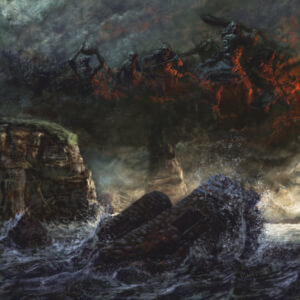 Speaking of old gods, long before the farce of Abrahamic religions invaded the west and north, indigenous populations in each region worshipped their own pantheon of (pagan) gods, with an uncanny similarity between the deities from each territory. While their Norse, Greek and Roman counterparts might be better known, the Celts had their gods, too, armed with their universally-plagiarised promise that we will reap as we sow. Are these the figures portrayed on the cover artwork of ‘Nahanagan Stadial’, wreaking retribution, with the club-wielding Dagda leading the annihilation?
Speaking of old gods, long before the farce of Abrahamic religions invaded the west and north, indigenous populations in each region worshipped their own pantheon of (pagan) gods, with an uncanny similarity between the deities from each territory. While their Norse, Greek and Roman counterparts might be better known, the Celts had their gods, too, armed with their universally-plagiarised promise that we will reap as we sow. Are these the figures portrayed on the cover artwork of ‘Nahanagan Stadial’, wreaking retribution, with the club-wielding Dagda leading the annihilation?
“The cover represents the great flood or the catastrophic event that occurred during the Nahanagan Stadial. The Irish druids, identifiable by the fact that they fought on the battlefield, represent a reset back to the ways of old.
“It also encompasses the great storm referenced in ‘Feast of the Epiphany’, when 200 years ago waves topped The Cliffs of Moher in the west of Ireland, the first point of contact for any event as ferocious as this. The Christian people of the Island were convinced the ancients had returned to reoccupy the land, when they for the first time saw red auroras, revealed only between lightning strikes.The castle in the sea on the cover represents the present, O’Briens Castle currently sits atop these cliffs.
“When standing out on these powerful landforms – the likes of the Cliffs of Moher, Dún Ducathair on Inis Mór or deep in the caves of Oweynagat in Cruachán – it’s not hard to understand why these deities were worshipped and feared.”
Are you casting your mind both back and forward at the same time? Is an episode such as the Nahanagan Stadial a fitting metaphor for the pivotal, cataclysmic times we live in today, with a perceptible sense of doom permeating everything and mankind seemingly teetering on the brink of a rapturous Armageddon?
“Driving up through some US cities on the west coast and after also visiting the east last year, it accelerates the feeling that we’re reaching the end times for western civilisation. Once great cities and beacons of hope for devastated generations of Irish people appear to be reaching their demise. Other once great nations which weren’t as kind to our ancestors in mainland Europe and the UK are reaching a similar fate. However, the ethos of the band is not so defeatist in attitude. Victory can always come again with a great flood.”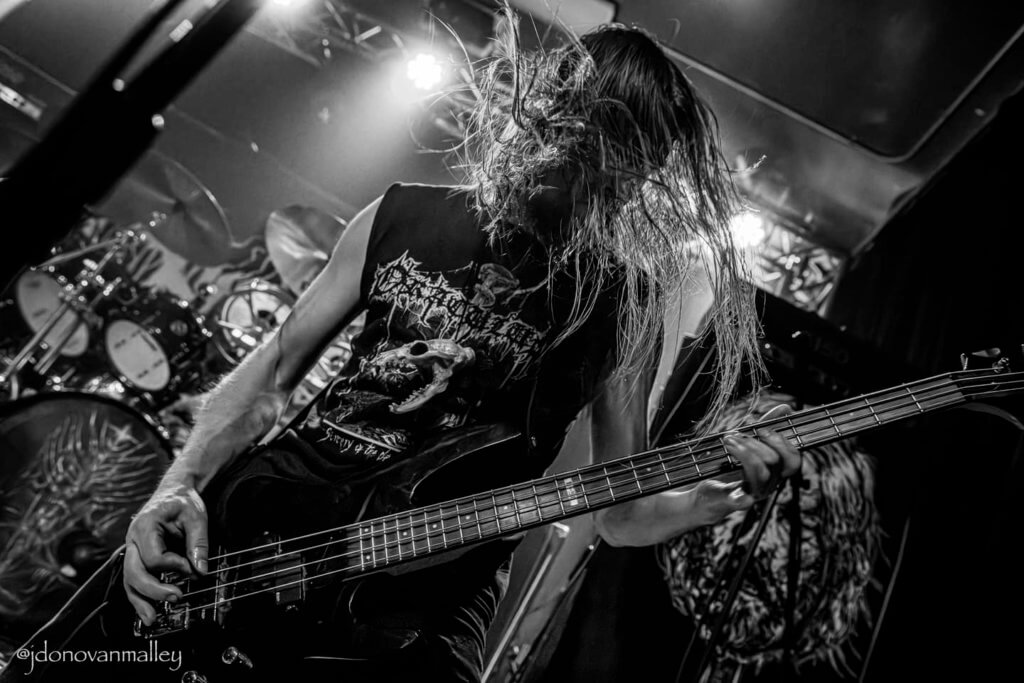 Coscradh’s reverence for the native Irish tongue reflects a strong passion for heritage and lineage. While some would argue that nationality is merely an accident of birth, we are products of the immediate environment around us, the nutrients in the soil, the water in the lakes, rivers and sea, the distinctive prevailing climate of each region, the blood and DNA passed down through generations. Is it important to acknowledge the unique culture / characteristics of our land and our people, to celebrate it and – if possible – preserve and prolong it? Is Ireland losing this battle?
Coscradh’s reverence for the native Irish tongue reflects a strong passion for heritage and lineage. While some would argue that nationality is merely an accident of birth, we are products of the immediate environment around us, the nutrients in the soil, the water in the lakes, rivers and sea, the distinctive prevailing climate of each region, the blood and DNA passed down through generations. Is it important to acknowledge the unique culture / characteristics of our land and our people, to celebrate it and – if possible – preserve and prolong it? Is Ireland losing this battle?
“You are correct, we’ve a fierce passion for our history and culture as a band and I believe that still reflects the majority of people on our island, although you need to venture outside the capital to fully realise it. As hard as the current powers of the world may try to erase individual western nationhood, I believe they still can’t take it away from us as the Irish story is a unique one, with a just victory against the Saxon tyrannical power and having a uniquely opposing Celtic culture and history, revived by Padraic Pearse in opposition to the educated young of the time aligning more with the Brits.
“To this day, our ancient music, dance, sport and many other traditions couldn’t be more prominent even if our language is still only flourishing in my own region of the west. The usage of Gaelic language in Coscradh reflects the particular brutal stories being told and attempts to reflect the time period. All of these important parts of our culture have grown and transformed regionally, you could live and travel here for a lifetime and (as much as I’ve tried) still will never know or understand every little piece of history and tradition that has evolved out of every town, village, valley or mountain.”
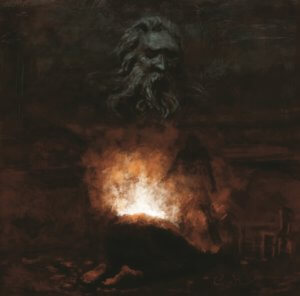 There is indeed an inherently powerful, evocative, raw and authentic might to Black / Death Metal delivered in one’s native tongue. Already deeply chaotic and unsettling, the vocals on Coscradh’s curses cast as gaelige are embellished with an additional otherworldly element. How do you determine which songs are going to be executed in Irish? Your two most epic offerings – the aforementioned ‘Saor sa hAnbháis’ and album closer ‘Feallaire Dóite’ – have Irish lyrics and I would be surprised if this is a coincidence…
There is indeed an inherently powerful, evocative, raw and authentic might to Black / Death Metal delivered in one’s native tongue. Already deeply chaotic and unsettling, the vocals on Coscradh’s curses cast as gaelige are embellished with an additional otherworldly element. How do you determine which songs are going to be executed in Irish? Your two most epic offerings – the aforementioned ‘Saor sa hAnbháis’ and album closer ‘Feallaire Dóite’ – have Irish lyrics and I would be surprised if this is a coincidence…
“The subject of the song usually determines this. ‘Saor sa hAnbháis’ (Freedom in Slaughter) is set in middle Ireland from the perspective of a delirious visit to a tomb to talk to the ancients while ossified on poitín, an extremely alcoholic ancient / illegal drink made from fermented potato skins (and still available today). A self sacrifice which occurred in my region in Connemara.
“‘Cladh Hálainn’ is a 3600-year-old ritual site in Outer Hebrides in Scotland. The song is written in Scots Gaelic, but unlike other celtic languages, this language is so similar to Irish that it can be easily read and understood, and back when this event occurred they were the same people. On this island local mythology spoke of a druid in the area but – only recently excavated – four sites of ritual sacrifice were revealed in the ancient, traditional manner: throat cut, asphyxiation, blunt force and burning. Myth passed down by word of mouth through thousands of years becoming fact; it shows that the people and the land are as one.
“‘Fealaire Dóite’ (Immolated Deceiver) is a more recent event (1900). Written from the perspective of Michael Clearly, one of the last remaining Irish Bards, locals used to come to him for tales of myth and folklore. Beginning to show signs of psychotic behaviour, Michael was concerned his wife had been spending too much time at the local ‘Kylenagranna’ ringfort, a circular enclosure left behind by pre-celtic tribes. Brigid had been asking the ancients to cure her infertility in keeping with an old tradition. Many of these traditions were seen by some as invoking evil. Micheal burned her alive over the course of a few days.This is the image on the back of the LP, depicted by Khaos Diktator. This represents both an annihilation of an ancient culture but also renewal by becoming possessed by it.”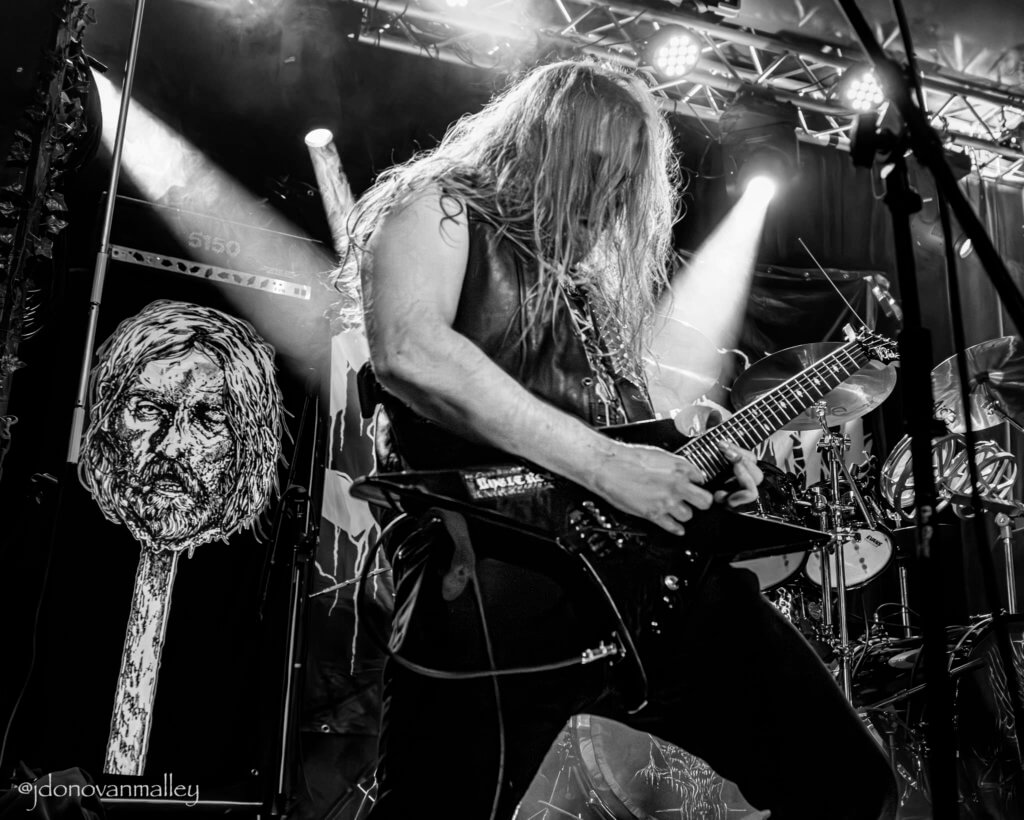 Music – both performing and absorbing it – is one of the beacons of Irish culture. Historically, a love of song and dance has always existed across this ill-treated land – from traditional ceol to songs of rebellion to producing some of the world’s most profitable pop. But, compared to most other northern European territories, a decidedly limited appetite for Death / Black Metal is evident. How did Coscradh’s crusade commence in such a stagnant ‘scene’? Musically, did you draw inspiration from distant destroyers like Teitanblood as much as from compatriots and would-be labelmates Malthusian?
Music – both performing and absorbing it – is one of the beacons of Irish culture. Historically, a love of song and dance has always existed across this ill-treated land – from traditional ceol to songs of rebellion to producing some of the world’s most profitable pop. But, compared to most other northern European territories, a decidedly limited appetite for Death / Black Metal is evident. How did Coscradh’s crusade commence in such a stagnant ‘scene’? Musically, did you draw inspiration from distant destroyers like Teitanblood as much as from compatriots and would-be labelmates Malthusian?
“Hick and myself probably attend more traditional music sessions than metal, Jason is fairly adept in the genre himself, Boban is a Croat but soon to meet the same fate, haha. The underground black or death scenes here are only a small handful of people scattered across the country, mainly basing themselves in Dublin. I constantly compare it to the size of the metal scene of a Middle Eastern or Asian country; if people aren’t into pop music here they’re into Irish music, and after that there are tiny subcultures for everything where everyone knows each other.
“Ourselves, Malthusian, Slidhr, Mourning Beloveth, Vircolac, Sacrilegia, Incessant, Hasturisn Vigil, Verminous Serpent, Zealot Cult and Unyielding Love basically have a small number of members between the whole lot. Even though we do get a lot of comparisons to our friends Malthusian, one of the the inspirations to start the band came from a temporary crossover of the metal / punk scenes in about 2012/14, where Zom from Dublin were kicking ass around Europe, and I remember thinking ‘how the fuck are these punks playing death metal are we’re not?!’ For direct musical influences I’m not sure exactly, but Teitanblood, Diocletian, Master’s Hammer, Tormentor, Beherit, Cultes des Ghoules, Deicide, Morbid Angel, Slayer, Burzum, Mayhem are all regularly spun amongst our ranks.”
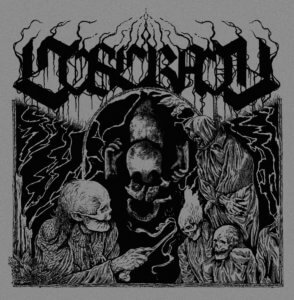 As a more-than-worthy companion piece to the LP edition of ‘Nahanagan Stadial’, you also gave the self-titled demo and ‘Of Death and Delirium’ EP a remastered-for-vinyl reboot, with those seven old recordings collated onto one record titled ‘Crá Aosta’. Why did you decide the time was right to reissue those old tracks? Was it the ideal way to draw a line under that period in the band’s history? And finally, now that the age of oblivion has arrived, can you make any predictions as to what the future might hold for Coscradh?
As a more-than-worthy companion piece to the LP edition of ‘Nahanagan Stadial’, you also gave the self-titled demo and ‘Of Death and Delirium’ EP a remastered-for-vinyl reboot, with those seven old recordings collated onto one record titled ‘Crá Aosta’. Why did you decide the time was right to reissue those old tracks? Was it the ideal way to draw a line under that period in the band’s history? And finally, now that the age of oblivion has arrived, can you make any predictions as to what the future might hold for Coscradh?
“‘Crá Aosta’ (Ancient Torment) – taken from the lyrics of ‘Saor sa hÁnbháis’. This was Darragh’s scheme. These releases previously only appeared on a limited tape and a CD in 2016/17, so it was great to finally see them on wax.
“We are currently a few songs into writing for our next release(s). We have gigs coming up in Europe this and next year, and are looking forward to more incursions into foreign shores.”
